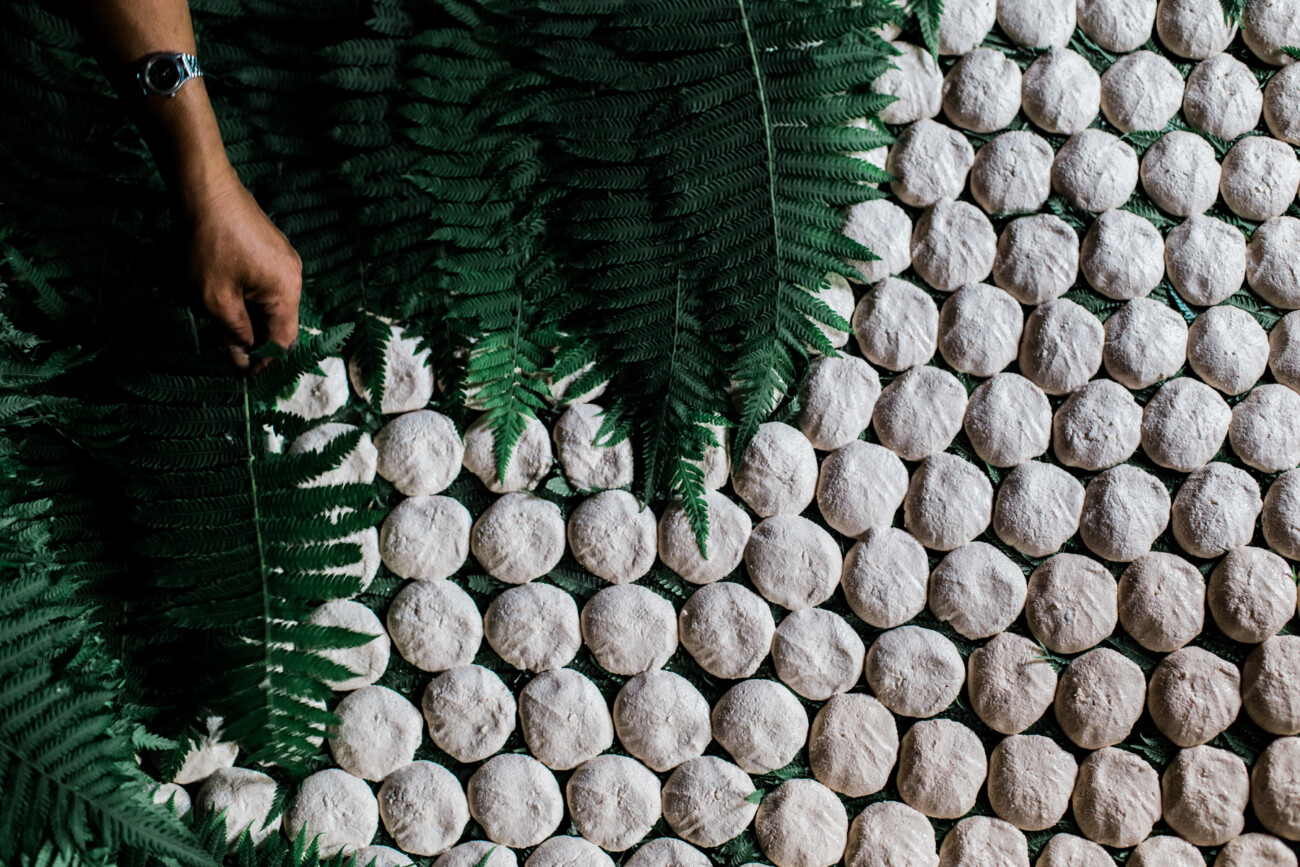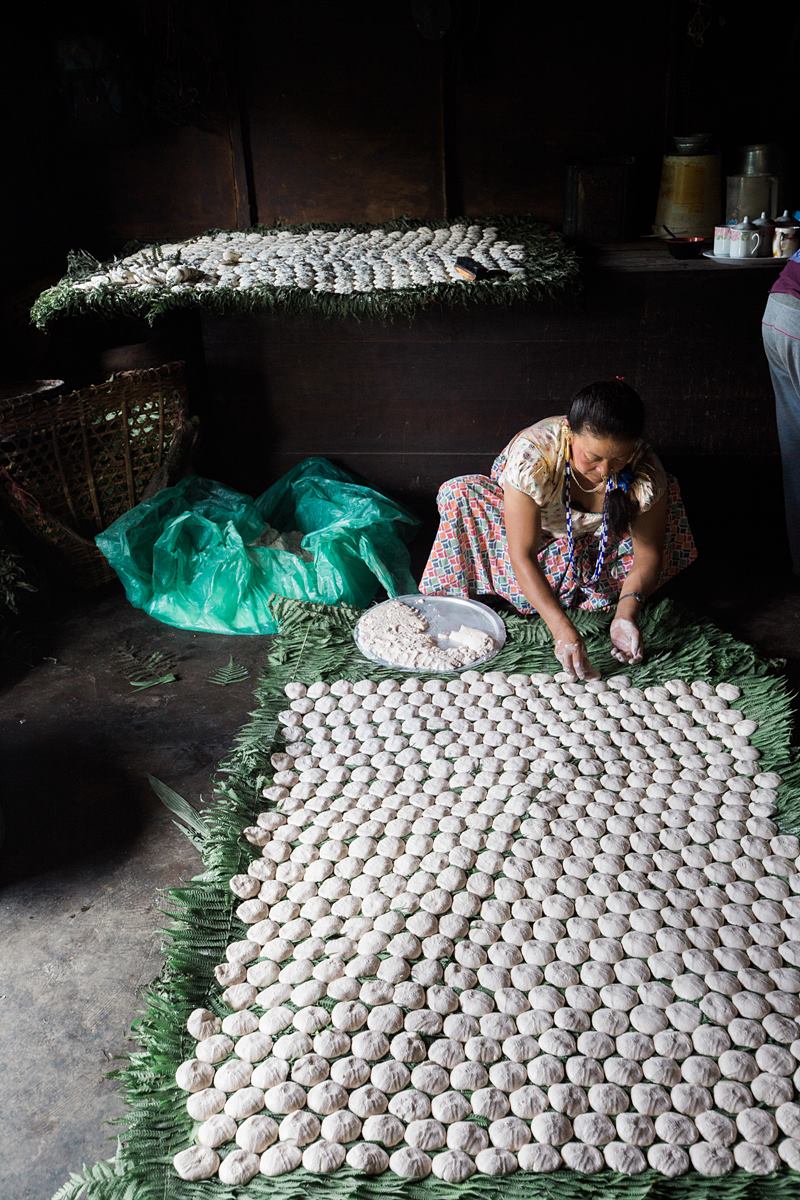The day we went to meet Phipmaya Limbu at Tikjek, a small hamlet near Gyalshing, West Sikkim, the terraces rippled with green paddy. The descent from the spot where we alighted our vehicle, down to the lower parts of the hills, was well rewarded. We entered the house where our host was waiting to demonstrate the process of making a special ingredient for preparing of an all-important brew.
Phipmaya Limbu tells me softly that the yeast she makes is called khesung in Limbu language. All tribes in Sikkim have their own yeast, for in all these communities brewing of chi or chang is central to their lives, as it is used in important ceremonies like marriages, funerals and births, and rituals of worship and propitiation. It is a potion that transports you from the mundane to the spiritual. While the fermentation and making of chang was an integral part of most households, the making of khesung, the yeast, is a specialized activity.

The skill and knowledge of making khesung follows a matrilineal line, passed on from mother to daughter. Phipmaya is a fifth-generation daughter in line in her family. When a young girl is still a virgin, her mother takes her aside and teaches her about the yeast-making process. She then emphasizes the importance of refraining from eating certain foods, especially those that have a pungent smell and a sour taste, so no onions, radish and fermented foods.
The ingredients that are used to make khesung are rice, ginger, chillies, a little portion of the earlier yeast and a special root of a plant which is only found in the highlands. The identity of the plant is a well-guarded secret.

The importance of khesung has not diminished over the years. Although distillery manufactured alcohol has replaced its use on many occasions, the brew made by using khesung is still in great demand.
Usually, twenty-five kilograms of rice is soaked overnight, and the next morning it is drained and pounded in a dekhi (mortar). This is done by men. Into the soaked rice, ginger, chillies (0.25 kilograms of each), and the roots of the secret herb are added. When this mixture is finely pounded, it is poured into a vessel and further kneaded by hand, adding an appropriate amount of the old khesung as a starter. When it is well mixed, a little is taken and patted by hand into round discs and laid neatly on a large bamboo tray and covered with a special fern called pirey uneo. When this process is over, the tray is lifted and put onto rafters over the fireplace. It takes seven days for the khesung to be ready.
Phipmaya usually starts the process on a Thursday evening. Like her mother she still takes her khesung to Gyalshing market on Fridays where she sells them for ten rupees a piece. She recalls accompanying her father, and sometimes her mother, selling them for as little as twenty-five paise a piece when she was a child.
The importance of khesung has not diminished over the years. Although distillery manufactured alcohol has replaced its use on many occasions, the brew made by using khesung is still in great demand. Earlier, when transport and communication were difficult, traders would trek over the hills and buy khesung from their home, but now orders are made on mobile phones and ease of transport allows the traders to pick up their orders from appointed collection points.
Khesung is also in demand for medicinal uses. It is used on boils and as a remedy for ailing animals. Phipmaya’s khesung travels to faraway places like Rabong, Kewzing and Damthang. As long as there is a demand for the product, the art of khesung making will surely be kept alive.
Photo Gallery
(Click to enlarge)














10 comments on “THE SECRET ART OF MAKING KHESUNG”
Leave a Reply
Latest Posts
Latest Comments
No 'Comments_Widget_Plus_Widget' widget registered in this installation.


I'm no longer certain where you're getting your information, however great topic.
I needs to spend a while studying more or understanding more.
Thanks for fantastic information I used to be on the lookout for
this info for my mission.
Where can I buy the khesung Puck in the USA?
Thanks
Chris
Intersting read. I remember my mam making chang/jaar using this, but she called it maar. It was also nice to read words ooneo, dheki. Took me bk to my childhood 😀 .
Interesting fact about preparing 'murcha', curious to know that secret root which is used.
Interesting fact about preparing 'marcha',
Good to know about it good blog want to read more from you.
Quite an amazing story. The details are rich and the photographs add great value to the article. Thanks a lot. I am sharing this in our group.
Nice read.
The photos very clearly depict the stage-wise process of making khesung.
It's nice to know that male and female members of the family are involved in making it
This is such an amazing read and the photographs have a very warm feeling to it. Absolutely great read this morning
Happy to know that you enjoyed the article and the photographs.